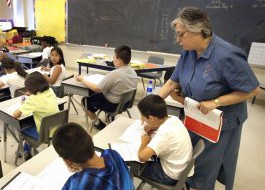
Nearly 69 million new teachers must be recruited and trained in order to achieve global universal primary and secondary education, figures from the UN Educational, Scientific and Cultural Organisation show, with sub-Saharan Africa and south Asia most affected by the worldwide shortage.
According to estimates from Unesco’s Institute for Statistics (UIS), published to coincide with World Teachers’ Day on 5 October, the international community needs to recruit 24.4 million primary school teachers, and 44.4 million secondary school teachers, in order to achieve the ambition of universal education outlined in the sustainable development agenda.
It is a huge aspiration, not least because an estimated 263 million children worldwide – including 25 million who are unlikely ever to receive any form of education – are out of school, according to a Unesco paper published this month. At secondary level, just 14% of young people in poor countries complete their studies.
In sub-Saharan Africa – the region with the fastest growing school-age population – more than 70% of countries face teacher shortages in primary schools, while 90% do not have enough secondary teachers, according to the data. In order to meet sustainable development goal four, which specifically calls for more qualified teachers and more teacher training in developing countries, roughly 17 million primary and secondary teachers will need to be recruited and trained in sub-Saharan Africa within the next 14 years.
South Asia faces the second largest teacher shortage, with an additional 15 million teachers – 11 million at secondary level – needed by 2030.
 Well-trained teachers are essential in classrooms. Whirlpool
Well-trained teachers are essential in classrooms. Whirlpool
“Entire education systems are gearing up for the big push to achieve sustainable development goal four by 2030,” said Silvia Montoya, director of Unesco’s institute of statistics.
“But education systems are only as good as their teachers. Global progress will depend on whether there is even a teacher, or a classroom, in which to teach with a manageable number of children instead of 60, 70 or even more pupils. We also need training, resources and support for teachers to do their job.”
The 2030 education goal builds on the millennium development goal to achieve universal primary schooling, under which enrollment in primary education rose from 83% in 2000 to 91% in 2015, according to UN figures.
Getting children into school is only the first step, said Unicef’s deputy executive director, Justin Forsyth, since the international community must also focus on how to keep them there.
“Well trained teachers are the key to children learning properly,” he said. “That’s why it’s important to close this education gap: without highly-trained teachers, children will go to school but they won’t have the skills to write, read or add up.”
In Ghana, pilot teacher training schemes have used technology including solar-powered infrastructure and satellite links to deliver distance learning courses. The $2m (£1.5m) Train for Tomorrow project, funded by Dubai Cares and delivered by the Varkey Foundation, involves instructing teachers face-to-face in “hub” schools so that, using interactive distance learning, they are then able instruct other educators.
The Varkey Foundation’s CEO, Vikas Pota, said: “The original 40 connected schools allow us to reach 5,000 teachers from our studios in Accra, and the project can be expanded by installing the technology package in further schools.”
Using this model, said Pota, training costs $200 a teacher until infrastructure is in place, at which point the cost decreases to $150 a teacher.
David Archer, head of programme development for ActionAid, recommended a broader approach to finding solutions. He said: “There are many innovative ways to improve the training and continuing professional development of teachers, and distance learning can play a role – but is not in itself a magic bullet.”
Unesco figures show that while the number of primary school teachers in Ghana has increased by 61% over the past decade, there was a decrease in trained teachers from 72% in 1999 to 53% in 2013. The distance-learning method allows teachers to learn novel methods of teaching, which, especially in Africa, have relied for too long on rote learning and dictation, said Pota.
Teachers also need to be paid more and paid on time, argue campaigners. Teachers’ salaries are often so low that they are forced to live hand-to-mouth, supplementing their work with other jobs or spending decades disputing their pay (as is the case in Kenya).
But other socioeconomic and gender factors affect how long a child stays in school, said Forsyth, who pointed to issues such as poor sanitation and the absence of doors on toilets as reasons why girls may stop attending school.
He said: “So many children go to school and then drop out because of poverty – they have to work instead. Or girls drop out because of lack of toilets, or because of embarrassment when they start menstruating.
“There are lots of other social and economic reasons that need to be addressed [to reach the 2030 education targets].”




